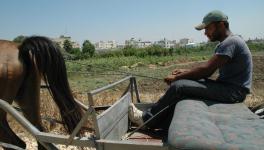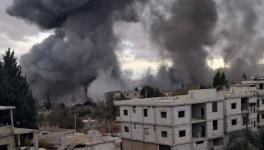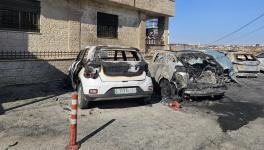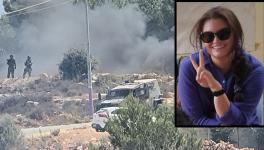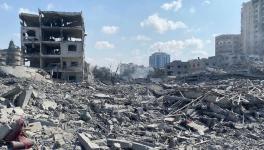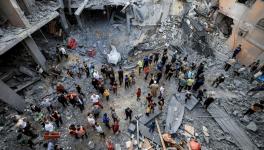CNN Probe Shows Veteran Al Jazeera Journo Deliberately Targeted by Israeli Forces
A CNN investigation has shown that veteran Al Jazeera journalist Shireen Abu Akleh was deliberately targeted by the Israeli Defence Forces (IDF) during a raid on the Jenin refugee camp, in West Bank, on May 11.
Contrary to the IDF’s claims, two videos of the scene of the shooting corroborated by the testimony of eight eyewitnesses, an audio forensic analyst and an explosive weapons expert suggest that when Abu Akleh (51) was shot dead, neither there was active combat nor any Palestinian militants near her.
Israeli military spokesperson Ran Kochav had told Army Radio on May 11 that Abu Akleh was “filming and working for a media outlet amidst armed Palestinians. They’re armed with cameras if you’ll permit me to say so,” according to The Times of Israel.
In a preliminary inquiry, the IDF had claimed that Abu Akleh was hit either by indiscriminate Palestinian gunfire or by an Israeli sniper positioned about 656 feet away in an exchange of fire with the Palestinians without providing evidence.
However, the CNN investigation shows that Abu Akleh was neither killed by mistake nor by Palestinians. In fact, a shaky video filmed by Al Jazeera cameraman Majdi Banura shows a calm situation before Abu Akleh, another Palestinian reporter Shatha Hanaysha and other journalists were targeted near the main Awdeh roundabout.
The Al Jazeera video shows Abu Akleh standing with the other journalists near the entrance of refugee camp while covering the raid. Though the footage does not show Abu Akleh being shot in the head, eyewitnesses told CNN that they believed that the IDF on the same street fired deliberately despite all of them wearing protective blue vests, identifying them as members of the media.
Another video filmed before Abu Akleh was killed and verified by Al Jazeera on May 20 shows relative calm and quiet before the IDF starts firing. Some people are seen talking and laughing in the foreground with people in the background, including Abu Akleh and some of her colleagues.
“We stood in front of the Israeli military vehicles for about 5 to 10 minutes before we made moves to ensure they saw us. And this is a habit of ours as journalists; we move as a group and we stand in front of them so they know we are journalists, and then we start moving,” Hanaysha told CNN.
Hanaysha, who couldn’t comprehend that the Israeli Army was targeting the, said, “As soon as she [Abu Akleh] fell, I honestly wasn’t comprehending that she [was shot] ... I was hearing the sound of bullets, but I wasn’t comprehending that they were coming at us. I thought they were shooting so we stayed back; I didn’t think they were trying to kill us.”
A 16-minute cell phone video clip filmed by Jenin resident Salim Awad (27) and shared with CNN shows him walking towards the spot where the journalists had gathered and zooming in on the Israeli armoured vehicles parked in the distance. “Look at the snipers,” he says. When a teenager peers tentatively up the street, he shouts: “Don’t kid around ... you think it’s a joke? We don’t want to die. We want to live.”
Awad too confirmed that there were no armed Palestinians or any clashes in the area. “There was no conflict or confrontations at all. We were about 10 guys, give or take, walking around, laughing and joking with the journalists. We were not afraid of anything. We didn’t expect anything would happen because when we saw journalists around, we thought it'd be a safe area.”
However, the situation changed dangerously within seven minutes, said Awad, whose video captures the moment when Abu Akleh, Hanaysha, another Palestinian journalist Mujahid al-Saadi and Al Jazeera producer Ali al-Samoudi, who was injured in the gunfire, were targeted as they walked towards the Israeli vehicles. Abu Akleh is seen turning away from the volley of gunfire barrage.
“We saw around four or five military vehicles on that street with rifles sticking out of them and one of them shot Shireen. We were standing right there; we saw it. When we tried to approach her, they shot at us. I tried to cross the street to help but I couldn’t,” Awad alleged adding that he saw a bullet hitting Abu Akleh by her ear.
A 16-year-old Palestinian who was among the group of men and boys on the street told CNN that “no shots were fired; no stones were thrown before Abu Akleh was shot. As gunfire erupted, he ducked behind a car parked three metres away and watched her being shot.
CNN reviewed 11 videos showing the situation before, during and after Abu Akleh was killed from different angles. The videos don’t capture the moment she was shot as the eyewitnesses filming them were also in the line of fire.
The CNN review of the visual evidence includes a body camera video released by the IDF which captures soldiers wielding M16s and M4s and running through a narrow alley as they spread out onto the street where the armored vehicles are parked. An Israeli military source told CNN, however, claimed that both sides were firing M16s and M4s.
The videos show five Israeli vehicles lined up in a row on the same road where Abu Akleh was killed. The vehicle closest to the journalists, emblazoned with a white number one, and the vehicle furthest away, marked with the number five, are positioned perpendicular across the street. Towards the rear of the vehicles, directly above the numbers, is a narrow rectangular opening in the exterior of the vehicle.
In the preliminary probe, the IDF had mentioned that the journalist may have been hit by an Israeli soldier shooting from a “designated firing hole in an IDF vehicle using a telescopic scope” during “the exchange of fire”. In fact, several eyewitnesses told CNN that they saw sniper rifles sticking out of the openings before the shooting began.
“They were shooting directly at the journalists,” alleged Jamal Huwail, a professor at the Arab American University, Jenin, who helped drag Abu Akleh’s body from the road. He described the vehicles as new models “which had openings for snipers”.
According to Chris Cobb-Smith, an explosives expert, a security consultant and a British army veteran, videos filmed during early morning of May 11 show Israeli soldiers and Palestinian militants battling each other with M16s and its variants. The M16 fires 5.56mm bullets, which means a joint Israeli-Palestinian probe is needed since both sides use the assault rifle—but Israel has not launched a criminal investigation and the Palestinian Authority has ruled out a joint probe.
However, Cobb-Smith concludes that Abu Akleh was killed in discrete shots, not a burst of automatic gunfire. After looking at imagery obtained by CNN, which shows bullet markings on the tree where Abu Akleh fell and Hanaysha was taking cover, he said, “The number of strike marks on the tree where Shireen was standing proves this wasn’t a random shot. She was targeted.”
Cobb-Smith added that the majority of gunfire from Palestinians captured on camera that day were “random sprays” citing two videos that showed Palestinians firing haphazardly down alleys in different parts of Jenin. The videos were circulated by the office of Israeli Prime Minister Naftali Bennett and Israel’s foreign ministry with a voiceover in Arabic saying: “They’ve hit one—they’ve hit a soldier. He’s lying on the ground.”
The IDF’s preliminary probe showed that an Israeli sniper was 200 metres away from her when Abu Akleh was killed. Robert Maher, a professor of electrical and computer engineering at Montana State University who specialises in forensic audio analysis, assessed the footage of Abu Akleh’s shooting and estimated the distance between the gunman and the cameraman considering the rifle used by the Israeli forces. He also analysed the captures of two volleys of gunfire.
According to eyewitnesses, Abu Akleh was hit in the second barrage, a series of seven sharp cracks, or the ballistic shockwave of the bullet, which is followed approximately 309 milliseconds later by the relatively quiet bang of the muzzle blast, Maher wrote in an email to CNN. “That would correspond to a distance of something between 177 and 197 meters,” he wrote almost matching the Israeli sniper’s position.
Reiterating that Abu Akleh was targeted, Cobb-Smith that there was “no chance” that random firing would result in three or four shots hitting in such a tight configuration if fired from 200 metres. “From the strike marks on the tree, it appears that the shots, one of which hit Shireen, came from down the street from the direction of the IDF troops. The relatively tight grouping of the rounds indicate Shireen was intentionally targeted with aimed shots and not the victim of random or stray fire,” he told CNN.
On May 18, a senior Israeli security officer requesting anonymity flatly denied to CNN Abu Akleh was killed intentionally. “In no way would the IDF ever target a civilian, especially a member of the press. An IDF soldier would never fire an M16 on automatic. They shoot bullet by bullet,” the officer said belying Israel’s claim that Palestinian militants were firing “recklessly and indiscriminately”.
Besides, since no Israeli soldiers were reported killed on May 11, Bennett’s office said that the video suggested that “Palestinian terrorists were the ones who shot the journalist”.
However, when CNN geolocated the videos shared by Bennett’s office to the south of the camp, more than 300 meters away from Abu Akleh, the coordinates of the two locations—verified using the crowdsourced street imagery platform Mapillary—and footage of the area filmed by Israeli human rights group B’Tselem, they demonstrate that the shooting in the videos couldn’t be the same volley of gunfire that hit Abu Akleh and al-Samoudi.
Get the latest reports & analysis with people's perspective on Protests, movements & deep analytical videos, discussions of the current affairs in your Telegram app. Subscribe to NewsClick's Telegram channel & get Real-Time updates on stories, as they get published on our website.









